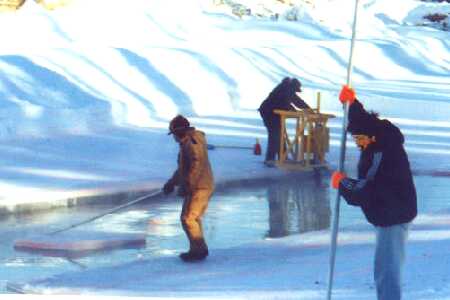 |
 |
|
O'Grady's Pond: The Place of Beginnings |
 |
 |
|
O'Grady's Pond: The Place of Beginnings |
Every story has to have a beginning, and in Ice Alaska's case each season's competition begins at O'Grady's Pond where Ice Alaska's elite team of gravel pit artists do their magic in creating the hundreds of blocked used each year in Ice Alaska.
The Quest for Ice
As hard to believe as at may sound, not too long ago Ice Alaska didn't have an ice source of its own. As a matter of fact in the first few years of the competition Ice Alaska imported all of its ice from ice houses in the lower 48. Which I might point out was extremely costly.
As the competition grew over the years so did its need for ice. On one particular year (198- ) it was suggested that the event should try to make use of local ice. As the story was told to me; a group of volunteers went out to a local lake bringing with them chainsaws, a Ditchwitch, pinch bars, and heavy equipment to lift out the ice blocks. When everything was said and done the results were very disappointing. The ice taken was filled with air bubbles, tree limbs, leaf debris, and even some fish were found frozen within the blocks.
Several years later a source of clean ice was discovered in a local gravel pit. The water which was used to wash gravel during the summer, gaving it the consistancy of a mud milk shake, making the pond free of fish, and any plant life. Once the gravel operation was closed for the season in late September, the sediment would then settle to the bottom leaving the ice harvested some months later crystal clear.
However as things turned out once again there were problems associated with the ice source. In this case it was discovered the following spring after harvesting the ice that the pond's water level had been lowered by several feet. To the dismay of the gravel pit's owner neither during the spring melt nor summer rains did the gravel pit's water line return to its former level.
This was situation was further exaservbated the following season when ice was again harvested from this source lowering the water level so much that the following spring it threatened the gravel pit owner's ability to conduct business.
It was around that time that ----- O'Grady proposed making a pond on Ice Alaska's property so in the summer of 1997 a pond (Dimensions) was dug. once they got down to such and such depth a spring was stuck and within a matter of days the pond was filled, and let settle for 1 season. Ice was first harvested from O'Grady's Pond in 1998.
Tools of the Trade
Far from an exact science the equipment and methods of harvesting ice have undergone a vast amount of change since Ice Alaska first began. cutting uniform blocks of ice has proved to be a difficult task. To attempt this Ditchwitches, the Rail sled and a myriad of other devises have been developed over the years. While each was a significant improvement over its predecessor, in the end the amount of labor to make that piece of technology work stretched Ice Alaska's volunteer staff to the limit.
The self propelled Gas Powered Railsled
Case and point is the Railsled. Developed by UAF up until 1998 this had been the hotest thing going to cut uniform straight blocks. The way this devise worked was by putting down a steel rail on the pond's surface and then hammering spikes into the ice to hold it in place. The rail sled them would run along the rail making a single logitudinal cut. The rail would then have to be pried loose, moved, and reset in order to make a second cut. Once two logitudinal cuts were made the sawyers would then move in, and make a series of traverse cuts woth hand held chainsaws to make the individual blocks.
All this might have been fine in a static environment, but with the tempertures during the Ice Harvest hovering anywhere between 20 - 60 below zero all the water kicked up by the Railsaw would freeze in a matter of seconds so as soon as the saw passed a team of would have to shovel off the ice and slush as fast as possible. Also freezing in such weather conditions were these 30' long logitudinal cuts themselves. So in order to cope with this, they needed a staff of over 30 laborers to speed along the processworking insensively to cope with the elements and the ice.
To give you an idea of how massive an undertaking this really is; last year in preperation for Ice Art 2000 Ice Alaska harvested over 2995 tons or 5.9 million pounds of ice.
Enter the Icesled
|
Tom Gullickson’s Icesled |
Simple, light weight, easy to maneuvor, and self-propelled, merely by the chainsaw's own inertia, the Icesled is truly a marvel of engineering.
In service for a second year running Tom Gullickson’s “Icesled” has revolutionized the ice cutting portion of Ice Alaska’s annual harvest. Not only with its speed, and ease of use; but by also having reduced the harvest's overall labor force from thirty volunteers working upwards of 10-12 hour days, to just five people working a standard 8 hour day.
 |
With use of the self-propelled, “Ice Sled” a single operator can now make precision blocks so fast that Ice Alaska's two forklifts can no longer keep up with them.